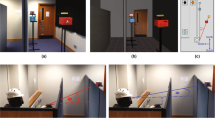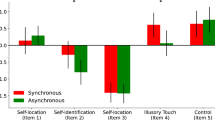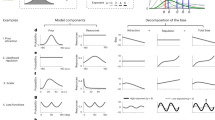Abstract
THE perception of two- and three-dimensional space has for long been one of the central issues in the experimental study of sensory and perceptual processes. An aspect of this problem is the apparent distortions of shape, size and direction which occur when the elements of a stimulus pattern (lines, angles, forms, etc.) are juxtaposed in certain spatial relationships. Such spatial illusions, which can be defined as discrepancies between the judged and true physical properties of the stimulus, have not yet been explained satisfactorily. It is clear, however, that their explanation would constitute a considerable advance in our understanding of the perceptual processes involved in space perception.
This is a preview of subscription content, access via your institution
Access options
Subscribe to this journal
Receive 51 print issues and online access
$199.00 per year
only $3.90 per issue
Buy this article
- Purchase on Springer Link
- Instant access to full article PDF
Prices may be subject to local taxes which are calculated during checkout
Similar content being viewed by others
References
Gregory, R. L., Nature, 199, 678 (1963).
Gregory, R. L., Listener, 16, 1736 (1962).
Gregory, R. L., Nature, 204, 302 (1964).
Tausch, R., Psychol. Forschung., 24, 299 (1954).
Brown, L. B., and Houssiadas, L., Nature, 204, 302 (1964).
Teuber, H-L., in Handbook of Physiology, Sect. I, Neurophysiology, edit. by Field et al. (American Physiol. Soc., Washington, 1960).
Kaufman, L., and Rock, I., Science, 136, 953, 1023 (1962).
Revesz, G., Z. Psychol., 131, 296 (1934).
Rudel, R. G., and Teuber, H.-L., Quart. J. Exp. Psychol., 15, 125 (1963).
Ratliff, F., in Sensory Communication, edit. by Rosenblith (John Wiley and Sons, Inc., New York, 1961).
Sanford, E. C., Experimental Psychology (D. C. Heath and Co., London, 1897).
Logan, J. A., Ph.D. thesis, Univ. Sydney (1963).
King, W. L., and Gruber, H. E., Science, 135, 1125 (1962).
Motokawa, K., J. Neurophysiol., 13, 413 (1950).
Author information
Authors and Affiliations
Rights and permissions
About this article
Cite this article
DAY, R. Inappropriate Constancy Explanation of Spatial Distortions. Nature 207, 891–893 (1965). https://doi.org/10.1038/207891a0
Issue Date:
DOI: https://doi.org/10.1038/207891a0
Comments
By submitting a comment you agree to abide by our Terms and Community Guidelines. If you find something abusive or that does not comply with our terms or guidelines please flag it as inappropriate.



